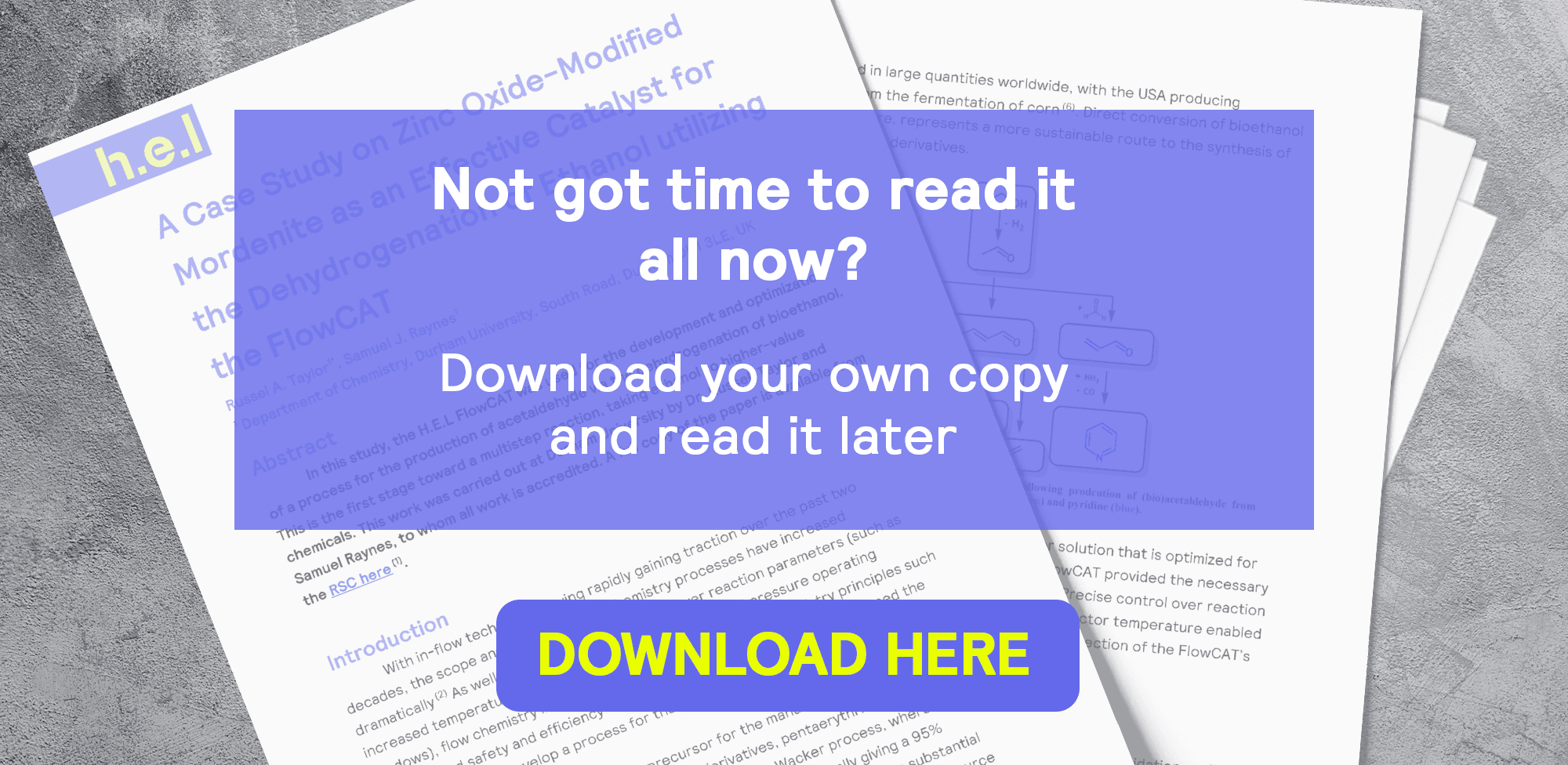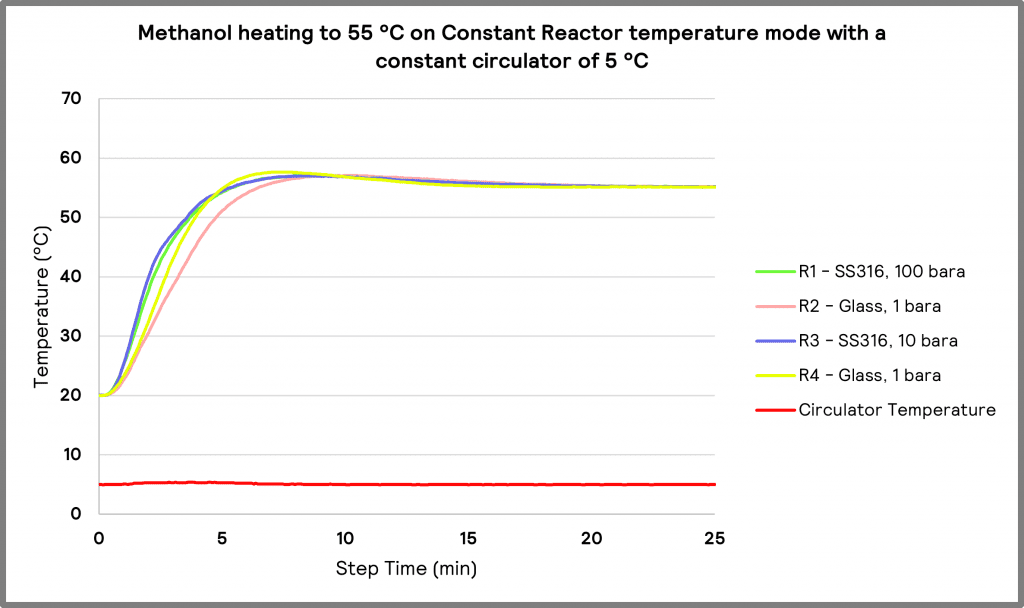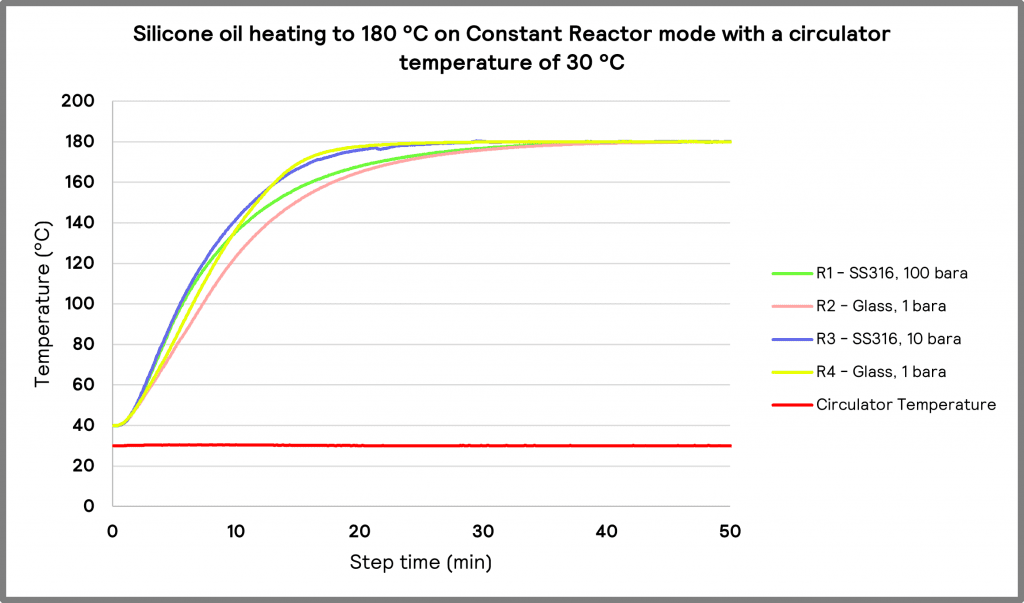Characterization of the heating capability for the multi-reactor PolyBLOCK 4
Aliko Chanda, Joseph Willmot
H.E.L Group, 9-10 Capital Business Park, Manor Way, London, WD6 1GW
This study investigated the heating temperature capabilities of the PolyBLOCK 4, a bench-top parallel reaction block, when connected to a circulator. Methanol and Silicone oil were the solvents heated in glass and stainless-steel reactors. The labCONSOL® control software enabled the use of different modes of heating, Heat/Cool Reactor, and Constant reactor. Connecting a circulator showed optimum temperature control characteristics. A maximum temperature difference of 150 °C was achieved between the internal temperature of the reactor and the circulator oil temperature. A stable ramping rate of 7 °C/min was also achieved in the glass and high-pressure reactors.
Introduction
The PolyBLOCK 4 is a versatile compact parallel reactor block with in-built heating and stirring capabilities, cooling can be achieved by an external circulator. This piece of equipment is used in chemical synthesis within process development and R&D. The four independently controlled reaction zones are beneficial for Design of Experiment (DoE) studies, and are also found in other products such as the BioXplorer and ChemSCAN ranges. Depending on the intended use, the reactor vessel will typically be glass or metal. Glass is often used for general synthesis and laboratory work while metal – typically stainless-steel (SS316) or Hastelloy (HC276) are used for high-pressure applications. Reactor vessels can range from as low as a 1 mL HPLC vial to 500 mL reactors, with aluminum adaptors available to support the full range of reactor sizes.
This study demonstrates the heating capabilities of the PolyBLOCK 4 by testing different solvents, reactors, and temperature control methods. Thereby providing a valuable guide to selecting the right combination of these factors when designing an experiment.
Materials and Method
For these characterizations, the PolyBLOCK 4 was used in standard laboratory conditions. Large SS316 and glass reactors were used; the SS316 reactors of 300 mL and 500 mL were placed in positions 1 and 3 (Figure 1). The 500 mL and 300 mL glass reactors were placed in positions 2 and 4 of the reactor (Table 1).
Methanol (CAS no.: 67-56-1), and Silicone oil (Huber P20-275-50) were the solvents used for these tests. In all cases, the stirring was provided via magnetically coupled agitation provided by the PolyBLOCK in-built magnetic stirrer at 400 rpm. Six-blade PTFE Rushton impellers were used in both the glass and metal reactors. In addition, a Huber Unistat 430 was attached to the PolyBLOCK to provide active cooling. The Unistat 430 is larger than the recommended circulator for a PolyBLOCK. However, it has similar cooling and heating capacities to other smaller models, and thus allows for a performance comparison.
labCONSOL® was used to operate the PolyBLOCK 4. The software can control the reactor in several modes, such as Constant Reactor Temperature or Heat/Cool Reactor (ramping reactor temperature). Heat/Cool Reactor changes the reactor temperature at a defined rate -see Figure 2.
In contrast, Constant Reactor Temperature Control (Figure 3) heats the reactor contents to a specified temperature as quickly as possible. Both heating modes were investigated.
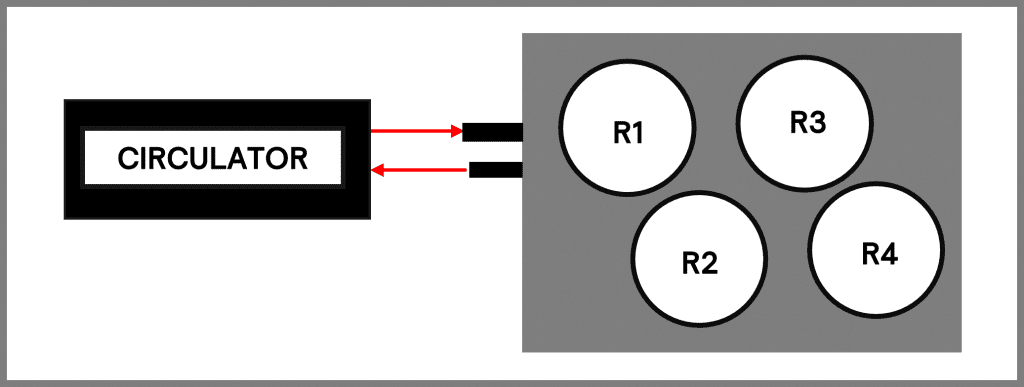 |
 |
| Figure 1. Reactor mantle positions within a PolyBLOCK 4 attached to a circulator with oil flow in and out the reactor |
Table 1. Details of the reactors used for heating characterizations, including size material of reactor and solvent volume. |
 |
 |
| Figure 2. Heat/Cool Reactor step on labCONSOL® heating by 5 °C/min to 120 °C with a stirring speed of 400 rpm. | Figure 3. Step of Constant Reactor on labCONSOL® heating to 120 °C with a stirring speed of 400 rpm. |
Results and Discussion
Evaluation of the Heat/Cool Reactor temperature control
Methanol has a low boiling point at 64.7 °C (cp 81.2 J/(mol K)). To avoid potential evaporation of the solvent, heating was only run to 55 °C. These characterizations investigated heating rates from 2°C/min to 10 °C/min in all reactors with a constant circulator temperature of 5 °C. A Huber Unistat 430 was used for the following characterizations, at 5 °C the circulator was providing 4 kW of power. Ramping to the set point at lower rates gave consistent results in all reactors. Heating at 3 °C/min (Graph 1) showed the best results in all reactors with no significant overshoots. Higher ramping rates achieved an average temperature change of the requested rate up to 6 °C/min.
Higher temperatures can be reached when testing Silicone oil. This solvent allowed for characterizations up to 200 °C. Several tests were completed, the first included heating to 120 °C by 2 °C/min up to 20 °C/min. Ramping at lower temperatures also showed the best temperature profiles when heating Silicone oil. However, with optimally tuned control parameters, 7 °C/min heating to 120 °C was achieved (Graph 2), with no significant overshoot or increase in circulator temperature.
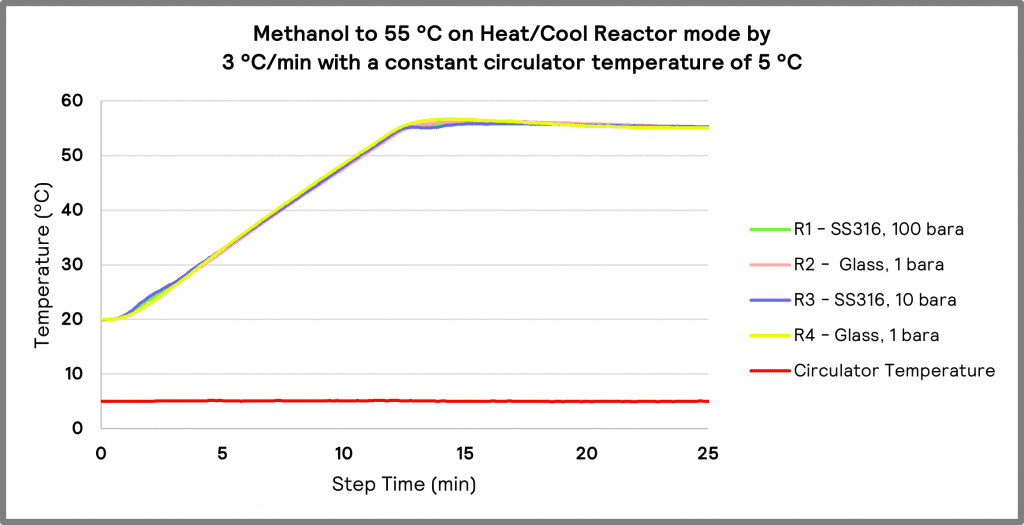 |
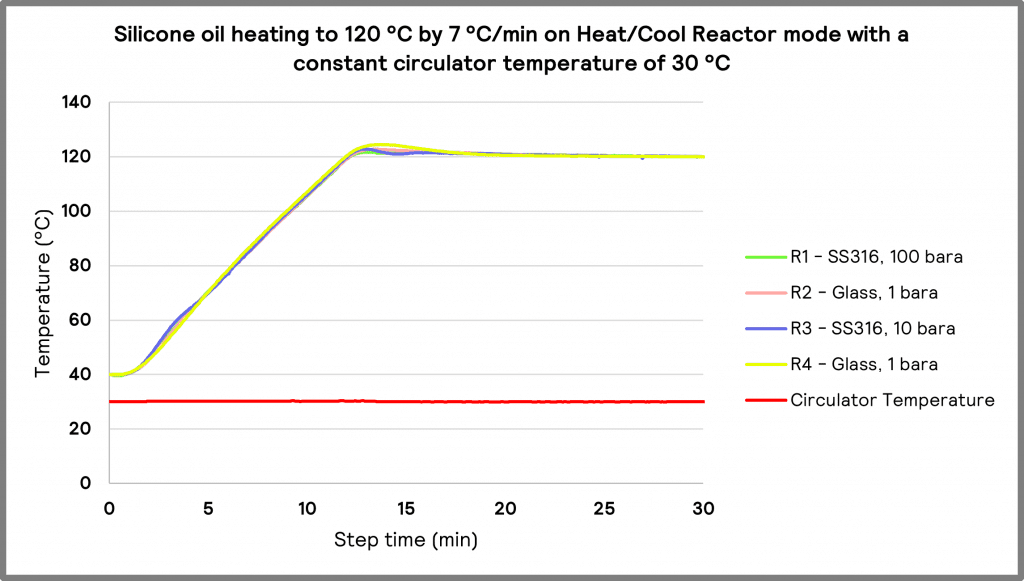 |
| Graph 1. Methanol to 55 °C on Heat/Cool Reactor temperature mode by 3 °C/min in the glass and high-pressure reactors with a constant circulator temperature of 5 °C. | Graph 2. Silicone oil heating to 120 °C by 7 °C/min on Heat/Cool Reactor mode with a constant circulator temperature of 30 °C. |
Evaluation of the Constant Reactor temperature control mode
Along with ramping Methanol to temperature, characterizations of the solvent heating on Constant Reactor temperature control mode were also completed. With these results, differences between reactor types were observed. This data shows a slight overshoot in temperature; however, it is still within the expected ±4 °C range. All reactors heated Methanol to temperature (after settling the overshoot) within 15 minutes of the step starting (Graph 3).
One of the tests conducted included heating the reactor temperature to 120 °C, 140 °C, 160 °C and 180 °C via Constant Reactor mode. This mode of temperature control heats the mantles as quickly as possible to achieve the desired reactor temperature. In all cases of heating, all of the reactors behaved similarly to each other. All reactors took less than 40 minutes to stabilize at 180 °C when heating from the 40 °C start point (Graph 4). This shows that while material of construction is important when it comes to reactor temperature control; the volume of solvent, stirring speed and reactor material can also affect the rates of heating.
Conclusion
The PolyBLOCK 4 achieved desired temperature control in all zones regardless of reactor material of construction or solvent. The maximum stable ramping rate achieved was 7 °C/min.
A maximum temperature difference of 150 °C between the circulator temperature and the internal temperature of the reactors was achieved. A larger temperature difference between the start and end temperatures was shown to reduce overshoot during heating steps.
These studies demonstrate that the solvent, heating rate, maximum temperature, and reactor material are all important experimental design considerations.
Acknowledgments
We want to thank the contribution of Dr. Paddy Delaney, for lending us a Huber Unistat 430 for these characterizations and other applications.

